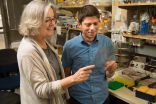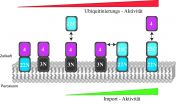(Press-News.org) Beverly, MA, September 22, 2014 – The American Association for Thoracic Surgery (AATS) has released new evidence-based guidelines for the prevention and treatment of perioperative and postoperative atrial fibrillation (POAF) and flutter for thoracic surgical procedures. The guidelines are published in The Journal of Thoracic and Cardiovascular Surgery.
"These guidelines have the potential to prevent the occurrence of atrial fibrillation in thousands of patients who undergo lung surgery in the United States each year. The AATS is committed to its goal of improving the care of patients around the globe who undergo cardiothoracic surgery each year. These guidelines will have a very positive impact on the outcomes of these patients," commented David J. Sugarbaker, MD, Director of The Lung Institute and Professor of Surgery, Baylor College of Medicine in Houston, TX, and Past President of the AATS.
Atrial fibrillation (AF) is the most common sustained cardiac arrhythmia, occurring in one to two percent of the general population. Many studies show an increase in mortality in patients with POAF, although it is not clear to what extent the arrhythmia itself contributes to mortality. POAF is also associated with longer intensive care unit and hospital stays, increased morbidity, including strokes and new central neurologic events, as well as use of more resources. Patients who develop POAF tend to stay two to four days longer in the hospital.
A task force of sixteen experts, including cardiologists, electrophysiology specialists, anesthesiologists, intensive care specialists, thoracic and cardiac surgeons, and a clinical pharmacist, was invited by the AATS to develop evidence-based guidelines for the prevention and treatment of perioperative/postoperative atrial fibrillation and flutter (POAF) for thoracic surgical procedures.
"Patients with preexisting AF represent a high-risk population for stroke, heart failure, and other POAF-related complications," says Gyorgy Frendl, MD, PhD, of the Department of Anesthesiology, Perioperative Critical Care and Pain Medicine, Brigham and Women's Hospital and Harvard Medical School, Boston, MA, who co-chaired the task force. "Some may present with valvular heart disease. The management of their antiarrhythmic medications and their perioperative anticoagulation may pose a challenge."
The task force examined evidence and adapted a standard definition for POAF. The task force also developed a set of recommendations for how to:
Define and diagnose POAF
Use physiologic (ECG) monitoring of patients at risk for POAF
Best manage and treat POAF
Use rate control and antiarrhythmic drugs, considering their mechanism of action, side effects, and limitations
Best manage the patient with preexisting AF
Manage anticoagulation for new-onset POAF
Manage (long-term) and how to follow patients with persistent new-onset POAF
Among the task force's main recommendations are:
Both electrophysiologically-documented AF and clinically diagnosed AF should be included in the clinical documentation and reported in clinical trials/studies.
Patients at risk for POAF should be monitored with continuous ECG telemetry postoperatively for 48 to 72 hours (or less if their hospitalization is shorter) if they are undergoing procedures that pose intermediate or high risk for the development of postoperative AF or have significant additional risk factors for stroke, or if they have a history of preexisting or periodic recurrent AF before their surgery.
In patients without a history of AF, who show clinical signs of possible AF while not monitored with telemetry, ECG recordings to diagnose POAF and ongoing telemetry to monitor the period of AF should be immediately implemented.
Recent evidence suggests that some prevention strategies, such as avoiding beta-blockade withdrawal for those chronically on those medications and correction of serum magnesium when abnormal, may be effective in all patients for reducing the incidence of POAF, but that some of these strategies are underused. The task force recommends that:
Patients taking beta-blockers before thoracic surgery should continue them (even if at reduced doses) during the postoperative period to avoid beta-blockade withdrawal.
Intravenous magnesium supplementation may be considered to prevent postoperative AF when serum magnesium level is low or it is suspected that total body magnesium is depleted.
Digoxin should not be used for prophylaxis against AF.
Catheter or surgical pulmonary vein isolation (at the time of surgery) is not recommended for prevention of POAF for patients who have no previous history of AF.
Complete or partial pulmonary vein isolation at the time of (even bilateral) lung surgery should not be considered for prevention of POAF, as it is unlikely to be effective.
For those patients at increased risk for the development of POAF, preventive administration of medications (diltiazem or amiodarone) may be reasonable. However, these strategies may not be useful for all thoracic surgical patients.
Guidelines for the management of patients with preexisting AF include: criteria for obtaining cardiology consults for preoperative AF; perioperative management of anticoagulation for patients on long-term anticoagulation (warfarin or new oral anticoagulants); postoperative resumption of anticoagulation; and postoperative follow-up. Specifically, catheter or surgical ablation of AF is not recommended for management of patients with postoperative AF after thoracic surgery.
"These guidelines are best used as a guide for practice and teaching. The applicability of these recommendations to the individual patient should be evaluated on a case-by-case basis, and only applied when clinically appropriate," comments Dr. Frendl and the task force. "In addition, these guidelines can serve as a tool for uniform practices, to guide preoperative evaluations, and form the basis of large, multicenter cohort studies for the thoracic surgical community."
INFORMATION: END
New guidelines issued for managing peri- and postoperative atrial fibrillation
American Association for Thoracic Surgery publishes key guidelines for prevention and treatment of POAF and flutter in the Journal of Thoracic and Cardiovascular Surgery
2014-09-22
ELSE PRESS RELEASES FROM THIS DATE:
Evidence supports deep brain stimulation for obsessive-compulsive disorder
2014-09-22
September 22, 2014 – Available research evidence supports the use of deep brain stimulation (DBS) for patients with obsessive-compulsive disorder (OCD) who don't respond to other treatments, concludes a review in the October issue of Neurosurgery, official journal of the Congress of Neurological Surgeons (CNS). The journal is published by Lippincott Williams & Wilkins, a part of Wolters Kluwer Health.
Based on evidence, two specific bilateral DBS techniques are recommended for treatment of carefully selected patients with OCD, according to a new clinical practice guideline ...
Involving female offenders in release planning can increase reintegration success
2014-09-22
TORONTO, Sept, 22, 2014--Women who are about to be released from prison need to be more involved in their discharge planning if they are to successfully reintegrate into their communities and avoid returning to prison, according to a new study.
Almost half of all female prisoners are back behind bars within one year of their release and most have multiple prison terms, mainly for drug-related offenses.
Dr. Flora Matheson, a researcher at St. Michael's Hospital, conducted one-on-one interviews with women who were about to be released or had been recently released from ...
Scientists discover an on-off switch for aging cells
2014-09-22
La Jolla -- Scientists at the Salk Institute have discovered an on-and-off "switch" in cells that may hold the key to healthy aging. This switch points to a way to encourage healthy cells to keep dividing and generating, for example, new lung or liver tissue, even in old age.
In our bodies, newly divided cells constantly replenish lungs, skin, liver and other organs. However, most human cells cannot divide indefinitely–with each division, a cellular timekeeper at the ends of chromosomes shortens. When this timekeeper, called a telomere, becomes too short, cells can no ...
Where is that spacecraft?
2014-09-22
Philadelphia, PA—Space surveillance is inherently challenging when compared to other tracking environments due to various reasons, not least of which is the long time gap between surveillance updates. "Unlike the air and missile defense environments where objects are frequently observed, the space surveillance environment data is starved, with many objects going several orbital periods between observations," according to researcher Joshua Horwood. "Thus, it is more challenging to predict the future location of these sparsely-seen objects and they have a tendency to get ...
Neurosurgery tackles past, current and future concepts of sports concussion
2014-09-22
September 22, 2014 - An estimated 1.68 to 3.8 million sports-related concussions occur in the United States each year, and there are likely a significant number that go unreported. Current Concepts in Sports Concussion is a comprehensive, 16-article supplement of Neurosurgery, official journal of the Congress of Neurological Surgeons. Chicago-area neurosurgeon Gail Rosseau, MD, the lead guest editor, is well known for her longtime commitment to sports-related head injury prevention, and serves on the Board of Directors of USA Football and ThinkFirst. Additional guest editors ...
Comprehensive Neurosurgery supplement covers sports-related concussions
2014-09-22
September 22, 2014 - Neurosurgeons have treated head and spinal sports injuries since the specialty was formed in the early 20th century, with formal efforts to mitigate these injuries dating back to 1931. Current Concepts in Sports Concussion is a comprehensive, 16-article supplement of Neurosurgery, official journal of the Congress of Neurological Surgeons, published by Lippincott Williams & Wilkins, part of Wolters Kluwer Health. The supplement includes a detailed, fascinating history of concussion treatment and research. The lead guest editor is Chicago-area neurosurgeon ...
Communication without detours
2014-09-22
Certain nerve cells take a shortcut for the transmission of information: signals are not conducted via the cell`s center, but around it like on a bypass road. The previously unknown nerve cell shape is now presented in the journal "Neuron" by a research team from Heidelberg, Mannheim and Bonn.
Nerve cells communicate by using electrical signals. Via widely ramified cell structures—the dendrites—, they receive signals from other neurons and then transmit them over a thin cell extension—the axon—to other nerve cells. Axon and dendrites are usually interconnected by the ...
The accelerator of molecular motors
2014-09-22
To their surprise, it turned out to be an old acquaintance: a certain module of the familiar protein Pex22p, which has hitherto always been considered an anchor protein. The researchers report their findings in PLoS One.
Essential: importing enzymes into peroxisome
Peroxisomes are of vital importance for the enzymatic degradation of long-chain fatty acids and cellular toxins. In order for them to fulfil this function, the relevant enzymes have to be imported into the peroxisomes first. The bulk is brought into a peroxisome by the import receptor Pex5p. That receptor, ...
Why do leaves change color in the fall? (video)
2014-09-22
WASHINGTON, Sept. 22, 2014 — It's the first day of autumn, and the telltale signs are here: crisp weather, pumpkin spice lattes and, most importantly, the leaves are changing colors. Ever wonder why some leaves turn red, others yellow and some just turn brown? We'll tell you all about the chemistry behind this seasonal spectacle in the latest Reactions episode. Learn all about it at https://www.youtube.com/watch?v=X0nWmTeQPfo.
Subscribe to the series at Reactions YouTube, and follow us on Twitter @ACSreactions to be the first to see our latest videos.
INFORMATION:The ...
Finding hints of gravitational waves in the stars
2014-09-22
Scientists have shown how gravitational waves—invisible ripples in the fabric of space and time that propagate through the universe—might be "seen" by looking at the stars. The new model proposes that a star that oscillates at the same frequency as a gravitational wave will absorb energy from that wave and brighten, an overlooked prediction of Einstein's 1916 theory of general relativity. The study, which was published today in the Monthly Notices of the Royal Astronomical Society: Letters, contradicts previous assumptions about the behavior of gravitational waves.
"It's ...
LAST 30 PRESS RELEASES:
New technique lights up where drugs go in the body, cell by cell
New study finds movement of fishing fleets can reveal shifts in marine ecosystems
Embargoed: New evidence points to potential treatment for vascular dementia
Study uncovers disrupted brain balance in alcohol dependence
Working in groups can help Republicans and Democrats agree on controversial content moderation online
Structural findings reveal how distinct GPCR ligands create different levels of activation
Anything-goes “anyons” may be at the root of surprising quantum experiments
UC review: Maximizing workplace opportunity for veterans
From generation to complex control: Metasurfaces make perfect vortex beams "within reach"
Thin-film lithium niobate-based detector: recent advances and perspectives
Exploring why some people may tend to persistently make bad choices
How cells balance their protein levels
Nirsevimab vs RSVpreF vaccine for RSV–related hospitalization in newborns
Effectiveness and impact of maternal RSV immunization and nirsevimab on medically attended RSV in US children
AI gives scientists a boost, but at the cost of too many mediocre papers
Next-generation vision model maps tree growth at sub-meter precision
Genes aren’t destiny for inherited blindness, study shows
MIT study: High-fat diets make liver cells more likely to become cancerous
Exposure to multiple fine particulate matter components and incident depression in the US Medicare population
Risk of burdensome health care spending over time in the US
Nirsevimab against hospitalizations and emergency department visits for lower respiratory tract infection in infants
New microfluidics technology enables highly uniform DNA condensate formation
A new strategy for immune tolerance
Super Mario Bros. help fight burnout: New study links classic games to boosted happiness
Deepest gas hydrate cold seep ever discovered in the arctic: International research team unveils Freya Hydrate Mounds at 3,640 m depth.
Integrating light and structure: Smarter mapping for fragile wetland ecosystems
ACA-SIM: A robust way to decode satellite signals over complex waters
Probiotics can restore gut microbiome in breastfed infants
AI could help predict nutrition risks in ICU patients, study finds
Federal EITC has unexpected result, researchers say – it decreases domestic violence
[Press-News.org] New guidelines issued for managing peri- and postoperative atrial fibrillationAmerican Association for Thoracic Surgery publishes key guidelines for prevention and treatment of POAF and flutter in the Journal of Thoracic and Cardiovascular Surgery




